
HOME
INTRO
SYMBOLS
ALMANAC
ECONOMY
GEOGRAPHY
STATE MAPS
PEOPLE
FORUM
NEWS
COOL SCHOOLS
STATE QUIZ
STATE LINKS
BOOK STORE
MARKETPLACE
GUESTBOOK
CONTACT US


You may double left-click on a word on this page to retrieve its definition. Tweet Follow
Ohio State Tree
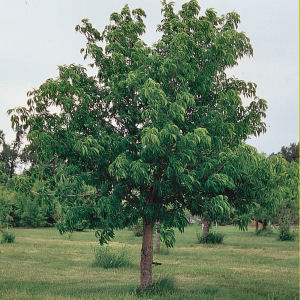
Ohio State Tree: Buckeye
USDA-NRCS PLANTS Database / Herman, D.E., et al. 1996.
North Dakota tree handbook. USDA NRCS ND State Soil
Conservation Committee; NDSU Extension and Western Area
Power Administration, Bismarck.
It was inevitable.
There were reasons not to vote for the buckeye tree as the official tree of the state, but they didn't matter. Unstoppable, the legislation to name the buckeye tree the official state tree of Ohio would pass and it would be enthusiastically endorsed by the governor of the state.
Buckeye. The word literally screams Ohio!
The people who come from or live in Ohio are called Buckeyes. The state's official nickname is the Buckeye State. Ohio State University's athletic teams are nicknamed Buckeyes. The circle on the state flag is said to represent the "O" in Ohio and the buckeye! And the tree... yes, the official state tree of Ohio is the buckeye tree (Aesculus glabra).
In the Ohio Senate, in debate over the legislation, Senator Arthur Blake railed
"The Ohio buckeye is known as the fettid [sic] buckeye and the stinking buckeye," Blake said. "It is a short and scrubby tree, has a thorny hide and its nuts are poisonous.
"I know they stink," Blake continued. I've had to cut them out of my pastures. I know they are poisonous because I had to bury a couple of cows that ate them."
"The buckeye tree is no good to anyone. Why do we honor a tree like this when we have the oaks, the hickories, the black walnuts and the ashes, all of them good trees?" Blake continued.
(" Senators Admit Buckeye Stinks But Vote For It to Become State Tree", 1953)
Still, Sen. Blake voted in favor of the bill and for the buckeye tree!
Sen. I. E. Baker summed it up, "I happen to be chairman of the committee which heard the bill. As bad as it stinks, I'm for the bill." [1]
The bill nominating the buckeye tree for the position of official tree of the state, House Bill No. 65, was sponsored by Representative Tom Barrett.
The Ohio Sesquicentennial Commission reported that the legislation sailed through the House and Senate.
The buckeye tree was designated the official tree of Ohio when Gov. Frank J. Lausche signed House Bill No. 65 on March 31, 1953. The law went into effect on October 2, 1953.
Was the buckeye really a worthless tree?
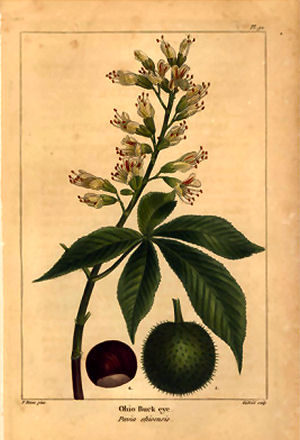
Ohio State Tree: Buckeye
Buckeye tree prints
No.
It's said that the early settlers valued its welcoming shade in the summer. They admired the beautiful springtime blossoms and were intrigued with the autumn nuts that resembled the eye of a deer. And folk wisdom had it that carrying a buckeye, or more, could ward of rheumatism and gout and bring good luck.
Settlers did find uses for the buckeye tree. They fashioned troughs, platters and baby cradles from the soft wood. Buckeye wood was even used to make artificial limbs.
Containing a cleaning agent of sorts and being very starchy, the ground buckeye could be used for washing clothes and starching them.
Maybe a factor in honoring the buckeye is a certain admiration of the tree's perceived toughness. The tree seems adaptable, growing where other trees can't or have a hard time. It's a survivor.
In a humorous 1883 speech, Dr. Daniel Drake, author of Picture of Cincinnati extolled
"In all our woods there is not a tree so hard to kill as the buckeye. The deepest girdling does not deaden it, and even after it is cut down and worked up into the side of a cabin it will send out young branches, denoting to all the world that Buckeyes are not easily conquered, and could with difficulty be destroyed."
"Ohio State History and Traditions."
Perhaps these are traits that Ohioans can identify with. All of the Ohioans we have met are proud to be called buckeyes.
Ohio Law
The following information was excerpted from the Ohio Revised Code, General Provisions, Chapter 5, Section 5.05.
GENERAL PROVISIONS
CHAPTER 5: STATE INSIGNIA; SEALS; HOLIDAYS
5.05 State Tree.
5.05 State Tree.
The tree, Aesculus glabra, commonly known as the "Buckeye" is hereby adopted as the official tree of the state.
Effective Date: 10-02-1953
Sources...
"5.05 State Tree." Ohio Revised Code. State of Ohio, n.d. Web. 26 Nov. 1998.
Frank, Dorothy. "Along the Way." Chronicle-Telegram [Elyria] 12 May 1953: 6. Print.
"Ohio State History and Traditions." Ohio State University. Ohio State University, n.d. Web. 28 Nov. 2016.
"Senators Admit Buckeye Stinks But Vote For It to Become State Tree." The Coshocton Tribune 25 Mar. 1953: 1. Print.
Shearer, Benjamin F. and Barbara S. State Names, Seals, Flags and Symbols: A Historical Guide Third Edition, Revised and Expanded. Westport, Conn: Greenwood Press, 3 Sub edition, 2001.
"Twin Buckeye Trees Attest To His Love For Ohio." The Newark Advocate and American Tribune 13 Aug. 1952: 1. Print.
"Wants Aesculus Globra As Ohio State Tree." Register-Star-News [Sandusky] 25 Feb. 1953: 18. Print.
Additional Information
Ohio Buckeye Aesculus glabra: Ohio Department of Natural Resources, Division of Forestry.
7 Things to Know About Growing an Ohio Buckeye Tree: The Ohio State University, College of Food, Agricultural, and Environmental Sciences.
Aesculus glabra Willd. (Ohio buckeye) Plant Guide from the United States Department of Agriculture's (USDA) Natural Resources Conservation Service.
Plant Guide from the United States Department of Agriculture's (USDA) Natural Resources Conservation Service.
Ohio buckeye Aesculus glabra Willd.: Virginia Tech Department of Forest Resources and Environmental Conservation.
Aesculus glabra Willd. (Ohio buckeye): USDA, NRCS. 2016. The PLANTS Database (http://plants.usda.gov). National Plant Data Center, Baton Rouge, LA 70874-4490 USA.
Aesculus glabra Willd.: Integrated Taxonomic Information System (ITIS).
Aesculus glabra Willd.: Plants For A Future (PFAF): researching and providing information on ecologically sustainable horticulture.
Aesculus glabra: Search for images of Aesculus glabra with Google.
State trees: Complete list of official state trees from NETSTATE.COM.
More symbols & emblems: Complete list of official Ohio state symbols from NETSTATE.COM.
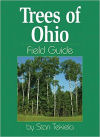
Trees of Ohio
Stan Tekiela
Trees of Ohio, by Stan Tekiela. 256 pages. Adventure Publications (April 6, 2004)
With this famous field guide by award-winning author and naturalist Stan Tekiela, you can make tree identification simple, informative and productive. Learn about 115 Ohio trees, organized in the book by leaf type and attachment. Fact-filled information contains the particulars that you want to know, while full-page photos provide the visual detail needed for accurate identification. Trees are fascinating and wonderful, and this is the perfect introduction to them.
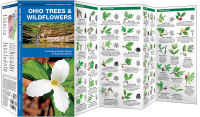
Ohio Trees & Wildflowers
James Kavanagh
Ohio Trees & Wildflowers: A Folding Pocket Guide to Familiar Plants, by James Kavanagh. Folding pamphlet. Waterford Press; 1st edition (May 1, 2008)
The state tree, the famous Ohio Buckeye, is one of thousands of species of plants growing in the diverse ecosystems found throughout the state. This beautifully illustrated guide highlights over 140 familiar and unique species of trees, shrubs and wildflowers and also includes an ecoregion map featuring prominent botanical sanctuaries. Laminated for durability, this lightweight, pocket-sized folding guide is an excellent source of portable information and ideal for field use by visitors and residents alike. Made in the USA.
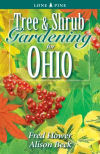
Tree and Shrub
Gardening for Ohio
Fred Howe, Alison Beck
Tree and Shrub Gardening for Ohio, by Fred Howe, Alison Beck. 360 pages. Publisher: Lone Pine (January 22, 2004)
With this beautiful book at your fingertips, you can select, plant and care for the trees and shrubs that suit the conditions present in your garden:
- Detailed listings for 82 different species of trees and shrubs, along with information on more than 860 recommended varieties and cultivars best suited for Ohio gardens
- Size, shape and growing zone
- Notes on the best features of each species or variety
- Seasonal color
- What tree or shrub to select for a specific location
- How to plant, prune and propagate
- Soil, moisture and sunlight requirements
- Year-round maintenance
- Tips for solving pest and disease problems
- More than 575 color photographs and illustrations

